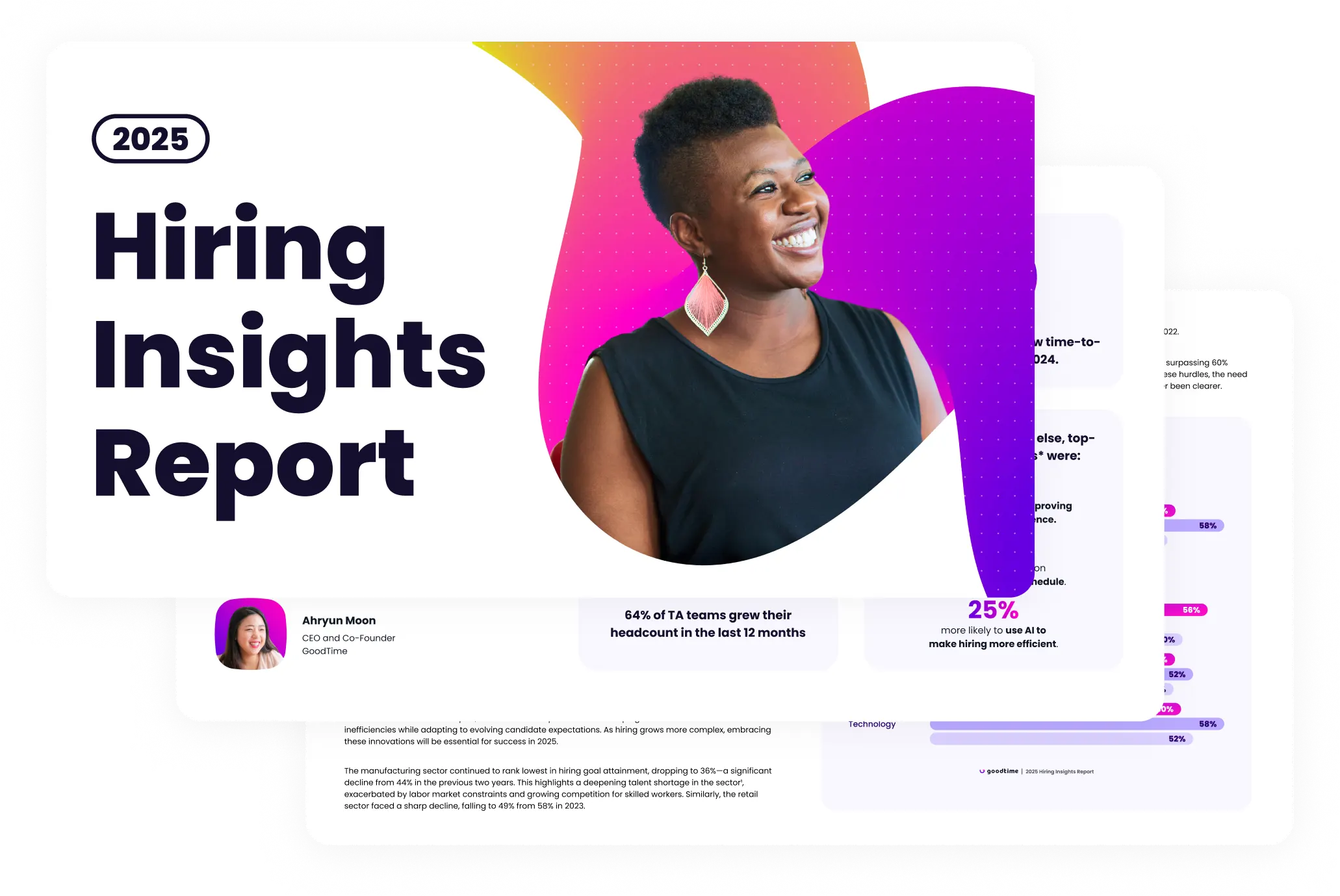A well-planned recruitment budget can be a game-changer for your hiring process. It can help you control costs and position your organization to attract top talent.
Understanding how to create and optimize your recruitment budget is necessary for meeting your hiring goals. Remember, the competition for top talent is tough. In fact, 24% of talent acquisition leaders say finding qualified candidates is one of their biggest challenges.
But before discussing practical tips on structuring your budget for success, let’s first define a recruitment budget and its components.

Unlock 2025’s top hiring strategies: Insights from 500+ TA leaders
Be the first to uncover deep hiring insights specific to your sector — straight from the highest-performing TA teams.

What is a recruitment budget?
A recruitment budget is a financial plan that outlines the costs associated with attracting, hiring, and onboarding new employees. It covers everything from job ads to recruitment software and internal team expenses. A recruitment budget helps you align your hiring efforts with your organization’s financial capacity, allowing you to allocate resources wisely and avoid overspending.
Without a clear budget, your hiring process can become inefficient. Costs can spiral out of control. Even worse, you may miss out on hiring top candidates because you didn’t allocate enough resources to important areas, such as job ads or recruitment tools.
Having a recruitment budget lets you scale your efforts competently. It allows you to focus on what works, cut unnecessary expenses, and confidently plan for future hiring needs.
Key components of a recruitment budget
Creating an effective recruitment budget requires understanding where your money is going. Here are the main components to consider when coming up with a recruitment budget:
Job advertisements
One of the most indispensable expenses in recruitment is advertising job openings. This includes posting on job boards, using social recruiting, or even running paid campaigns on platforms such as LinkedIn.
While these platforms offer wide reach, the costs can quickly add up. To optimize this area, assess the performance of your campaigns and focus spending on platforms that yield the best results. For instance, if your job postings on LinkedIn generate more qualified candidates than those on a job board, it may be worth shifting more of your budget to LinkedIn.
Recruitment tools and software
Recruitment software can be a huge asset in streamlining your process. Whether it’s an applicant tracking system (ATS) to manage applications or scheduling tools to set interviews, these tools can automate your workflow and save time. However, they also come at a cost.
When budgeting for recruitment software, consider the size of your organization and your hiring needs. If you’re a small business, you might not need an enterprise-level ATS. A simpler, more affordable solution could work just as well.
Agency or third-party recruiter fees
If you use external agencies or headhunters to find candidates, these fees can add up quickly. While outsourcing recruitment may be necessary in some cases, such as when expanding into a new region, you should understand how much you’re paying for these services and whether they’re truly adding value.
Consider negotiating fees or setting clear expectations upfront to prevent overspending. If your company often hires for specialized roles, such as senior engineers, working with a recruitment agency can be a smart move since they have the right expertise and connections. But if you’re paying high fees to fill common roles, like entry-level positions, it might make more sense to grow your internal hiring team.
Think about how many roles you need to fill and what types of positions they are. This can help you decide whether to rely on your internal team or bring in outside help.
Employer branding initiatives
Your company’s reputation as an employer plays an important role in attracting top talent. Candidates want to feel confident they’re joining a place that values its employees, offers growth opportunities, and maintains a positive work culture.
Investing in employer branding, whether through social media, content marketing, or video testimonials, can help position your organization as a great place to work. This investment may not have immediate, tangible results, but over time, it will pay off.
Consider allocating part of your recruitment budget to building your employer brand, especially if you’re in a competitive market. This could mean sponsoring events or highlighting your company culture online. The goal is to create a positive image that resonates with potential candidates who want to join your company.
Internal team costs
It’s not just external costs you need to budget for. Your internal team’s time and expenses also contribute to your recruitment budget. This includes salaries for your HR team, costs for interviewer training, and any technology or resources your team uses to support the hiring process. These costs can easily be overlooked, but they should be accounted for in your budget.
Our 2024 Hiring Insights Report reveals that talent teams spend approximately 35% of their time scheduling interviews. Automating these tasks would give talent acquisition teams free hours every week to focus on higher-value work. This is why you should consider automation tools.
How to create your recruitment budget
Now that you understand the key components of a recruitment budget, let’s look at how to create one. It’s important to approach this process strategically to align your budget with your organization’s goals and needs. Here’s how you can create your recruitment budget step-by-step:
Step 1: Review historical hiring data
Start by reviewing your past hiring efforts. Analyze recruitment metrics such as cost per hire, time to fill, and the channels that produced the best candidates. This data will provide a clear foundation for forecasting your recruitment needs in the future.
Our 2024 Hiring Insights Report has found that most talent acquisition teams focused on the quality of hire as the most important hiring metric this year.
If you’ve consistently found great candidates through employee referrals, it may be worth increasing the budget for referral bonuses while decreasing spending on job boards.
Step 2: Forecast hiring needs
Next, forecast your hiring needs for the upcoming year. Consider factors such as turnover rates and new projects or departments that will require additional staff. If your company plans to expand into new markets, you might need to allocate an additional budget for recruitment campaigns in those regions.
Step 3: Align with organizational goals
Your recruitment budget should be in sync with your broader organizational goals. If your company is aiming for rapid growth, you may need to allocate a larger budget to recruitment activities. On the other hand, if you’re aiming for stability or downsizing, you may need to tighten your budget and focus on more cost-effective hiring strategies.
Step 4: Track and adjust your budget over time
Once your recruitment budget is in place, track your spending and adjust as necessary. Recruitment costs can shoot up depending on market conditions, so being flexible is important.
Monitor metrics, such as the cost per hire and time to fill, and evaluate whether you’re staying within your budget. If certain areas are underperforming, such as a job board that isn’t yielding qualified candidates, you may need to reallocate those funds to a more effective channel.
Strategies to optimize your recruitment budget
Once you set your recruitment budget, the next step is to optimize it. This means finding ways to improve efficiency and get the best return on your investment (ROI). Here are some strategies to consider and the best results:
Take advantage of free or low-cost channels
Sourcing candidates does not always require expensive ads. Take advantage of free or low-cost channels, such as your company’s career page, employee referrals, or organic social media posts. This can help you reach a broad audience without draining your budget.
Employee referrals, in particular, can be a powerful and cost-efficient way to find candidates. Offering a referral bonus can motivate employees to recommend people they know and trust, helping you find candidates who are a good cultural fit.
Use automation to reduce manual workload
Recruitment automation tools can significantly reduce the manual workload involved in recruitment. Using an automated scheduling tool can save hours of administrative time, while an ATS can streamline candidate tracking and communication. These tools save time and reduce the likelihood of human error, making your recruitment process more effective.
Measure ROI to focus spending on high-performing areas
Tracking the ROI of your recruitment activities is important when it comes to optimizing your budget. Regularly keep track of the channels and strategies that are delivering the best results. Focus your spending on the areas that offer the most significant return, and cut back on underperforming strategies.
If paid ads on LinkedIn generate more quality applicants than job board listings, then reallocating funds to LinkedIn ads can improve your overall hiring performance.
Making your recruitment budget work for you
Creating and optimizing your recruitment budget isn’t a one-time task. It’s an ongoing process. Regularly assess your spending, analyze the effectiveness of your strategies, and adjust as needed. Remember, your budget is a tool to help you meet your hiring goals and attract the talent your organization needs to succeed.
GoodTime can help you streamline your hiring process even further with automation. By automating interview management tasks, from scheduling to messaging, you can save your talent acquisition teams valuable time and effort to focus on other pressing tasks. This can increase candidate experience and improve hiring results, lowering the hiring expenses at the same time.





